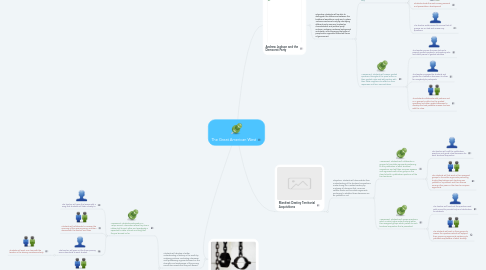
1. Slavery & Primary Sources
1.1. Students will develop a better understanding of slavery in the south by analyzing pictures, evaluating interviews, and synthesizing arguments based on the strengths and weaknesses of the primary source documents that they will dissect.
1.1.1. Assessment: Students participate in a "whip-around" discussion where they toss a rubber ball to each other and everybody is expected to state at least one thing that they've learned so far.
1.1.1.1. The teacher will open the lesson with a song that students will listen closely to.
1.1.1.2. Students will collaborate to uncover the meaning of the opening song, and then discuss with the teacher as a class
1.1.1.3. The teacher will pass out the three primary source handouts to each student
1.1.1.3.1. Students will work as a class with the teacher in the slavery narratives activity
1.1.2. Assessment: Students will take a test which covers the material comprised of slavery and the primary source lesson. In this test, students will not only answer multiple choice questions which involve slavery in the United States but will also be required to analyze an image and dissect and evaluate the meanings of a short excerpt.
1.1.2.1. Students work together in pairs or groups to analyze the slave quarters document, and answer the following questions
1.1.2.2. Students work together to read the short slavery perspective excerpt and then answer the following reflective questions.
1.1.2.3. The teacher will facilitate a guided class discussion to go over what the students found in their research and compare view points.
2. Andrew Jackson and the Democrat Party
2.1. Objective:-Students will be able to distinguish the differences between the traditional Republican Party and Andrew Jackson’s Democrat Party by identifying different party manners, leadership characteristics, and political party motives; analyzing Jackson’s background and ideals; and comparing the types of people who supported these two forms of government.
2.1.1. Assessment: Students pair up in groups to form a google slides presentation. They define democracy in their own terms, compare it to Andrew Jackson's view of Democracy, and state how they would have handled any of his situations differently and why.
2.1.1.1. Students work together in groups and divide up research from appropriate materials.
2.1.1.2. Students define "Democracy" in their own words and come up with one definition as a group.
2.1.1.3. Students divide the work among research and presentation development
2.1.1.4. The teacher walks around to ensure that all groups are on task and answer any questions.
2.1.2. Assessment: Students will answer guided questions throughout the prezi lecture in their guided notes and with partner with their table neighbors to reflect on their responses and form new solutions.
2.1.2.1. The teacher pauses the prezi lecture to present guided questions, anticipatory sets, and other pieces of guided activities
2.1.2.2. The teacher engages the students and guides the classroom discussion to allow for everybody to participate
2.1.2.3. The students collaborate with partners and or in groups to reflect on the guided questions and other guided exercises to develop the best possible answers to share with the class.
3. Manifest Destiny Territorial Acquisitions
3.1. Objective: Students will demonstrate their understanding of the territorial acquisitions made during the Manifest Destiny by analyzing all decisions that American settlers made and formulate arguments pertaining to whether those decisions can be justified or not.
3.1.1. Assessment: Students will collaborate in groups to formulate arguments pertaining to the justification of each territorial acquisition, and will then compare answers and arguments with other groups in the class to build a justification spectrum of the five territories.
3.1.1.1. The teacher will craft the justification spectrum and guide class discussion for each territorial acquisition
3.1.1.2. The students will first work in their assigned groups to formulate arguments pertaining to why they believe each territory was justified or unjustified, and then discuss among other peers in the class to compare arguments.
3.1.2. Assessment: Students will answer questions which involve higher-order thinking within their assigned groups which pertain to each territorial acquisition that is presented.
3.1.2.1. The teacher will hand out the questions and walk around to provide help and clarification for students.
3.1.2.2. The students will work in their groups to answer the questions which will support their upcoming arguments pertaining to justifiable acquisitions of each territory.
